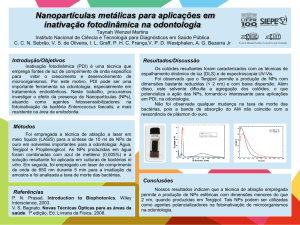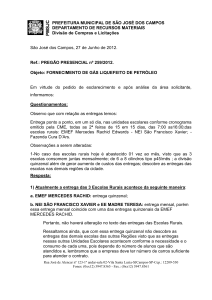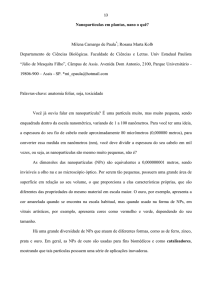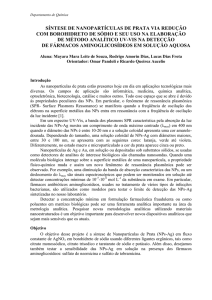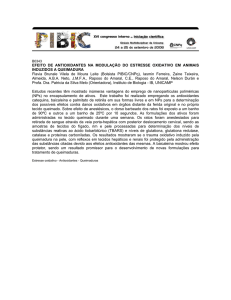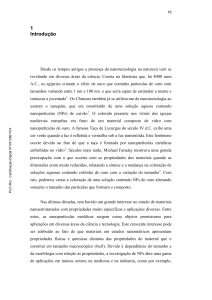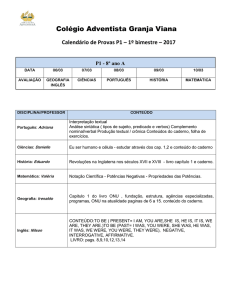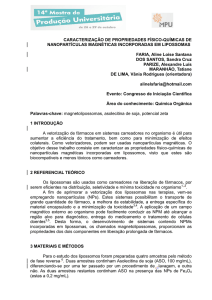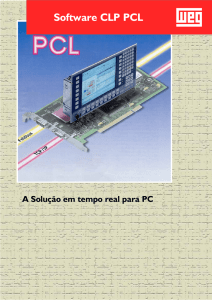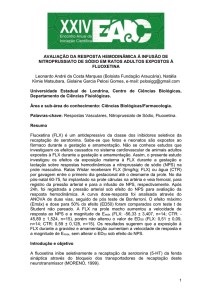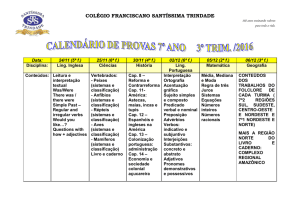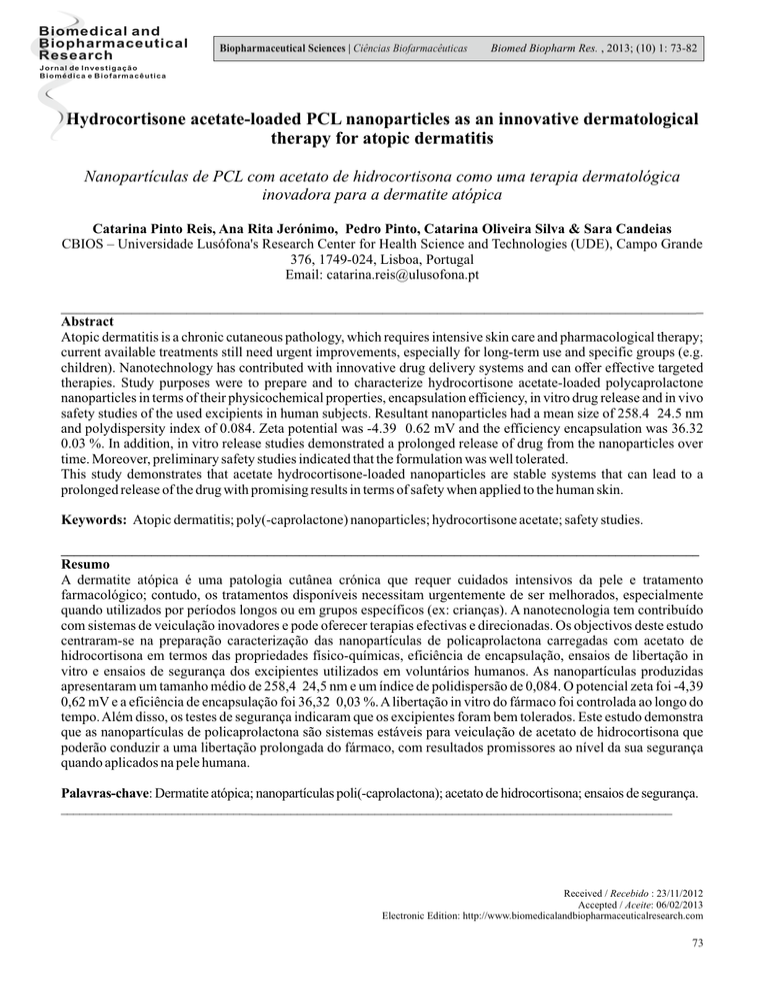
Biomedical and
Biopharmaceutical
Research
Biopharmaceutical Sciences | Ciências Biofarmacêuticas
Biomed Biopharm Res. , 2013; (10) 1: 73-82
Jornal de Investigação
Biomédica e Biofarmacêutica
Hydrocortisone acetate-loaded PCL nanoparticles as an innovative dermatological
therapy for atopic dermatitis
Nanopartículas de PCL com acetato de hidrocortisona como uma terapia dermatológica
inovadora para a dermatite atópica
Catarina Pinto Reis, Ana Rita Jerónimo, Pedro Pinto, Catarina Oliveira Silva & Sara Candeias
CBIOS – Universidade Lusófona's Research Center for Health Science and Technologies (UDE), Campo Grande
376, 1749-024, Lisboa, Portugal
Email: [email protected]
__________________________________________________________________________________
Abstract
Atopic dermatitis is a chronic cutaneous pathology, which requires intensive skin care and pharmacological therapy;
current available treatments still need urgent improvements, especially for long-term use and specific groups (e.g.
children). Nanotechnology has contributed with innovative drug delivery systems and can offer effective targeted
therapies. Study purposes were to prepare and to characterize hydrocortisone acetate-loaded polycaprolactone
nanoparticles in terms of their physicochemical properties, encapsulation efficiency, in vitro drug release and in vivo
safety studies of the used excipients in human subjects. Resultant nanoparticles had a mean size of 258.4 24.5 nm
and polydispersity index of 0.084. Zeta potential was -4.39 0.62 mV and the efficiency encapsulation was 36.32
0.03 %. In addition, in vitro release studies demonstrated a prolonged release of drug from the nanoparticles over
time. Moreover, preliminary safety studies indicated that the formulation was well tolerated.
This study demonstrates that acetate hydrocortisone-loaded nanoparticles are stable systems that can lead to a
prolonged release of the drug with promising results in terms of safety when applied to the human skin.
Keywords: Atopic dermatitis; poly(-caprolactone) nanoparticles; hydrocortisone acetate; safety studies.
___________________________________________________________________________________________________
Resumo
A dermatite atópica é uma patologia cutânea crónica que requer cuidados intensivos da pele e tratamento
farmacológico; contudo, os tratamentos disponíveis necessitam urgentemente de ser melhorados, especialmente
quando utilizados por períodos longos ou em grupos específicos (ex: crianças). A nanotecnologia tem contribuído
com sistemas de veiculação inovadores e pode oferecer terapias efectivas e direcionadas. Os objectivos deste estudo
centraram-se na preparação caracterização das nanopartículas de policaprolactona carregadas com acetato de
hidrocortisona em termos das propriedades físico-químicas, eficiência de encapsulação, ensaios de libertação in
vitro e ensaios de segurança dos excipientes utilizados em voluntários humanos. As nanopartículas produzidas
apresentaram um tamanho médio de 258,4 24,5 nm e um índice de polidispersão de 0,084. O potencial zeta foi -4,39
0,62 mV e a eficiência de encapsulação foi 36,32 0,03 %. A libertação in vitro do fármaco foi controlada ao longo do
tempo. Além disso, os testes de segurança indicaram que os excipientes foram bem tolerados. Este estudo demonstra
que as nanopartículas de policaprolactona são sistemas estáveis para veiculação de acetato de hidrocortisona que
poderão conduzir a uma libertação prolongada do fármaco, com resultados promissores ao nível da sua segurança
quando aplicados na pele humana.
Palavras-chave: Dermatite atópica; nanopartículas poli(-caprolactona); acetato de hidrocortisona; ensaios de segurança.
________________________________________________________________________________________________
Received / Recebido : 23/11/2012
Accepted / Aceite: 06/02/2013
Electronic Edition: http://www.biomedicalandbiopharmaceuticalresearch.com
73
Catarina P. Reis, et al.
Introduction
Introdução
Atopic dermatitis is a complex chronic dermatological
disease, characterized by a multifactorial etiology (e.g.
genetics factors, environmental factors and impaired
immune responses), which involves inflammatory and
pruriginous responses – [112]. This pathology has a
considerable impact on the quality of life since it
requires intensive skin care and continuous
pharmacological measures –[1,2,7,8,10,11,1315].
Currently, there is a broad spectrum of therapeutic
approaches including topical corticosteroids, such as
the hydrocortisone acetate (HCA), which has antiinflammatory, antipruritic and vasoconstrictive
properties [1,4,8,9,12,13]. The mechanism of action of
this topical therapeutic class is based on the drug's
ability to cross the stratum corneum. The percutaneous
absorption is related to numerous factors such as the
integrity of epidermal tissue, occlusive state and
formulation vehicle [16]. Although topical
corticosteroids are still important therapeutic agents
especially in intermittent immunological
hyperreactivity periods, they have demonstrated
significant side effects that can limit patient
compliance [1,4,8,9,12,13,17].
Nanotechnology has been applied in the context of
medicine and pharmaceutical sciences for diagnostic
purposes, treatment and prevention of a diversity of
pathologies [18,19]. Indeed, several groups
demonstrated that biodegradable polymeric
nanoparticles (NPs) are particularly relevant drug
delivery systems due to their great potential to deliver
the pharmacologically active compound to a specific
therapeutic target (increased specificity), to protect
pharmacological agents from degradation (increased
stability), to control their release rate and show a
reduced toxicological profile (safety and increased
– [18,2022]
biocompatibility)
. Moreover, NPs are
distinguished drug delivery systems due to their small
size (increased surface-area-to-volume ratio) as well as
strong adhesion to inflamed tissues [18,20,21,23].
Poly(-caprolactone) (PCL) is an interesting
biodegradable and biocompatible polymer, which
presents a significantly slower degradation than other
available biodegradable polymers (e.g. PLGA, PLA).
This fact is generally attributed to the resistance of
chemical hydrolysis and to the high permeability of
many drugs which leads to a significant retention
inside the NPs core –[2426]. Due to these properties, PCL is
a good candidate for developing long-term use and safe
drug delivery systems. We expect that encapsulation of
HCA into PCL NPs can enable a prolonged drug
release, associated with targeting action to
inflammatory skin cells (e.g. epidermal keratinocytes).
If this hypothesis is confirmed, HCA-loaded NPs could
reduce the adverse side effects associated with the
A dermatite atópica é uma doença dermatológica
crónica complexa - caracterizada por uma etiologia
multifactorial (ex: factores genéticos, factores
ambientais e respostas imunitária exacerbadas) - que
envolve uma resposta inflamatória e pruriginosa
[1,2,5,6,8,10,12]
. Esta patologia tem um impacto considerável
na qualidade de vida, uma vez que requer cuidados
intensivos da pele e medidas farmacológicas contínuas
[1,2,7,8,10,11,1315]
.
Actualmente existe um vasto espectro de abordagens
terapêuticas, incluindo os corticosteróides tópicos tais
como o acetato de hidrocortisona (AHC) que apresenta
propriedades anti-inflamatórias, antipruríticas e
vasoconstrictoras [1,4,8,9,12,13]. O mecanismo de acção
desta classe terapêutica a nível tópico é baseado na
capacidade do fármaco permear o estrato córneo. A
absorção percutânea está relacionada com uma série de
factores como a integridade do tecido epidérmico, o
estado oclusivo e o veículo da formulação [16]. Apesar
dos corticosteróides tópicos serem agentes
terapêuticos importantes, especialmente nos períodos
de hiper-reactividade imunológica intermitente, têm
demonstrado reacções adversas significativas que
[1,4,8,9,12,13,17]
podem comprometer a adesão terapêutica
.
A nanotecnologia tem sido aplicada no contexto da
medicina e das ciências farmacêuticas para fins de
diagnóstico, tratamento e prevenção de uma
diversidade de patologias [18,19]. De facto, vários grupos
de investigação têm demonstrado que as
nanopartículas poliméricas (NPs) biodegradáveis são
sistemas de veiculação de fármacos particularmente
relevantes devido ao seu grande potencial para
direccionar e distribuir o composto
farmacologicamente activo para o alvo terapêutico
específico (maior especificidade), proteger os agentes
farmacológicos da degradação (maior estabilidade),
controlar a sua libertação e apresentam um perfil
toxicológico reduzido (maior segurança e
– [18,2022]
biocompatibilidade)
. Além disso, as NPs
constituem um sistema terapêutico distinto devido ao
seu pequeno tamanho (razão área de superfície-volume
aumentada), assim como uma forte adesão aos tecidos
[18,20,21,23]
inflamados
.
A poli(-caprolactona) (PCL) é um polímero
biodegradável e biocompatível interessante pois
apresenta uma degradação mais lenta do que outros
polímeros biodegradáveis disponíveis (ex: PLGA,
PLA). Este facto pode ser atribuído a uma possível
resistência à hidrólise química e à elevada
permeabilidade a muitos fármacos, o que promove a
–[2426]
retenção destes últimos no núcleo das NPs
. Devido
a estas propriedades, este polímero é considerado um
bom candidato para o desenvolvimento de sistemas de
veiculação de fármacos a longo prazo e seguros.
74
Hydrocortisone acetate-loaded PCL nanoparticles as an innovative Therapy
Nanopartículas de PCL como uma terapia dermatológica inovadora
corticosteroid therapy, increase the efficiency of the
treatment and, eventually, reduce the number of
applications during the treatment, which may increase
[27]
the patients' compliance .
The objectives of this study are the preparation and
characterization of HCA-loaded PCL NPs and
evaluation of their physicochemical properties,
encapsulation efficiency (EE), drug release and safety
of NPs formulation.
Espera-se que encapsulação do AHC em NPs de PCL
conduza a uma libertação de fármaco controlada e
prolongada no tempo, associada a uma acção
direcionada para células inflamatórias da pele (ex:
queratinócitos epidermais). Se a nossa hipótese se
confirmar, as NPs com AHC poderão reduzir os efeitos
secundários relacionados com a terapêutica com
corticosteróides, aumentar a eficácia do tratamento e,
em última instância, reduzir o número de aplicações
durante o tratamento, aumentando a adesão do doente à
[27]
terapêutica .
Os objectivos deste estudo são a preparação e
caracterização das NPs de PCL carregadas com AHC e
avaliação das suas propriedades físico-químicas,
eficiência de encapsulação (EE), ensaios de libertação
e segurança das Nps.
Material and methods
Materiais e métodos
Chemical compounds
Hydrocortisone 21-acetate (MW: 404.50 g.mol−1) and
poly(-caprolactone) (MW: 14000 g.mol−1) were
obtained from Sigma-Aldrich (China and Japan,
respectively). Polysorbate 80 (TWEEN 80) was
supplied by Fluka Analytical/Sigma-Aldrich
(Switzerland). Dexamethasone (DM) (MW: 392.47
g.mol−1) was supplied by AppliChem (Germany) and
cortisone acetate (CA) (MW: 402.48 g.mol−1) was
obtained from The Laboratory Labor Dr. EhrenstorferSchafers (Germany). Hydrocortisone (MW: 362.46
.
−1
g mol ) was provided from Sanofi Aventis (Portugal).
All other chemicals were of reagent analytical grade.
Compostos químicos
21-Acetato de hidrocortisona (MM:404,50 g.mol−1) e
poli(-caprolactona) (MM:14000 g . mol −1 ) foram
obtidos à Sigma-Aldrich (China e Japão,
respectivamente). Polissorbato 80 (TWEEN 80) foi
fornecido pela Fluka Analytical/Sigma-Aldrich
(Suíça). Dexametasona (DM) (MM:392,47 g.mol−1) foi
fornecida pela AppliChem (Alemanha) e o acetato de
.
−1
cortisona (AC) (MM:402,48 g mol ) foi obtido do
Laboratory Labor Dr. Ehrenstorfer-Schafers
(Alemanha). A hidrocortisona (HC) (MM:362,46
.
−1
g mol ) foi obtida da Sanofi Aventis (Portugal). Os
restantes reagentes foram de grau analítico.
NPs production and extraction methods
HCA-loaded PCL NPs production
Empty and HCA-loaded PCL NPs were prepared by
modified solvent displacement method previously
[27]
referenced in the literature . In brief, 10 mg of HCA
were suspended in 20 mL of methanol and,
simultaneously, 250 mg of PCL were dissolved in 50
mL of acetone for approximately 30 min. These
preparations were added to 100 mL of external aqueous
phase that include 2% (v/v) of TWEEN 80 under
stirring rate of 100 rpm (IKA Labortechnik, RW 20n,
Germany). Particles were instantaneously formed.
Empty NPs were also prepared.
Métodos de produção e extracção das NPs
Produção das NPs de PCL com AHC
As NPs de PCL vazias e as carregadas com AHC foram
produzidas pelo método de deslocamento do solvente
[27].
modificado previamente referenciado na literatura
Resumidamente, 10 mg de AHC foram suspensos em
20 mL de metanol e, simultaneamente, 250 mg de PCL
foram dissolvidos 50 mL de acetona durante
aproximadamente 30 min. Estas preparações foram
adicionadas sob agitação a 100 rpm (IKA Labortechnik
RW 20n, Alemanha) a 100 mL de fase aquosa externa
que continha 2% (v/v) de TWEEN 80. As partículas
formaram-se instantaneamente. Foram também
produzidas NPs vazias.
NPs recovery method
Acetone was removed in a rotary evaporator at 40C and
the NPs obtained were then recovered from the
aqueous phase by centrifugation (High Speed Table
Top Centrifuge Z 36 HK, Hermle Labortechnik,
Germany) at 37130 g, -4C for 40 min.
Método de recuperação das NPs
A acetona foi removida num evaporador rotativo a 40C
e as NPs obtidas foram depois recuperadas da fase
aquosa por centrifugação (Centrífuga High Speed Table
Top Z 36 HK, Hermle Labortechnik, Alemanha) a uma
velocidade agitação de 37130 g, -4C durante 40 min.
75
Catarina P. Reis, et al.
Nps characterization
Empty and HCA-loaded PCL NPs were characterized
in terms of the mean particle size and zeta potential.
These parameters were measured in triplicate and were
determined by photon spectroscopy and
electrophoretic mobility with the Coulter Nano-sizer
(Delsa NanoTM C, Beckman Coulter, Inc., USA),
respectively. Polydispersity index was also evaluated.
Encapsulation efficiency (EE) of HCA into NPs
The non-encapsulated HCA (or free-HCA) was
recovered from HCA-loaded PCL NP by
centrifugation (37197 g during 40 min). The EE was
determined in triplicate by HPLC analysis of the freeHCA present in the supernatant using an optimization
of a previously described HPLC method [28]. The
HPLC system (Agilent 1100 series) includes a RP-18
column (250x4 mm internal diameter with a pore size
of 5 μm). The experimental conditions were: an
injection volume of 10 L and flow rate of 1.2 mL/min at
room temperature. The mobile phase was a mixture of
deionized water, acetonitrile and methanol (58:32:10,
v/v/v) and elution was carried out in isocratic
conditions with detection at 238 nm. All standard
solutions were dissolved in methanol. DM was used as
internal standard. HC and CA were used in the
optimization stages of method development to assure
baseline resolution of DM, HCA and its two main
degradation products. The method was validated for
linearity in the range 5-100 ppm and accuracy and
precision (intra- and interday) at two different levels of
concentration, in agreement with international
[29]
guidelines .
Caracterização das NPs
As NPs de PCL vazias e carregadas com HCA foram
caracterizadas em termos do tamanho médio de
partícula e potencial zeta. Estes parâmetros foram
medidos em triplicado por espectroscopia de fotão e
mobilidade electroforética com o Coulter Nano-sizer
(Delsa NanoTM C, Beckman Coulter, Inc., EUA),
respectivamente. O índice de polidispersão foi também
avaliado.
Eficiência de encapsulação (EE) do AHC nas NPs
A AHC livre ou não encapsulada foi isolada através de
centrifugação (37197 g duante 40 min) e a EE foi
determinada em triplicado através da quantificação do
AHC livre, presente no sobrenadante por optimização
de um método de HPLC previamente descrito [28]. O
sistema HPLC (Agilent série 1100) incluiu uma coluna
RP-18 (250x4mm diâmetro interno com 5 μm de
tamanho do poro). Utilizou-se um volume de injecção
de 10 L e um fluxo de 1,2 mL.min-1 com eluição à
temperatura ambiente. A fase móvel era composta por
uma mistura de água desionizada, acetonitrilo e
metanol (58:32:10, v/v/v) e a eluição foi desenvolvida
sob condições isocráticas. O comprimento de onda de
deteção foi 238 nm. Todas as soluções padrão foram
dissolvidas em metanol. A DM foi utilizada como
padrão interno. O HC e a AC foram usados unicamente
no desenvolvimento no método, para assegurar
resolução na linha de base da DM, do AHC livre e dos
seus produtos de degradação. O método analítico foi
validado para linearidade na gama 5 a 100 ppm e
precisão e exactidão (intra- e interdia) a dois níveis de
concentração, de acordo com directrizes internacionais
[29]
.
In vitro drug release assay
HCA-loaded NPs (10 mg) were placed in a recipient
containing 20 mL of PBS (pH 7.4) (USP XXX) without
enzymes and incubated at room temperature under
constant stirring (130 rpm). At appropriated time
intervals, aliquots were collected and replaced
immediately with fresh solution. A clear supernatant
was obtained after an ultracentrifugation (68600 g for
30 min). HCA concentration in the supernatant was
determined in triplicate using a UV-visible
spectrophotometer (Evolution 600, UK). A standard
calibration curve was performed with the HCA
solution in PBS 7.4. The established range was 1–25
µg.mL-1 (R2 >0.999).
Ensaio de libertação in vitro
As NPs carregadas com AHC (10 mg) foram colocadas
num recipiente com 20 mL de PBS pH 7,4 (USP XXX)
sem enzimas e incubadas à temperatura ambiente, sob
agitação constante (130 rpm). Em intervalos
apropriados, foram colhidas alíquotas e substituídas
imediatamente por tampão fresco. Obteve-se um
sobrenadante límpido após ultracentrifugação (68600
g durante 30 min). A concentração de AHC no
sobrenadante foi determinada em triplicado usando um
espectrofotómetro UV-visível (Evolution 600, Reino
Unido). Foi construída uma curva de calibração para a
solução de AHC em PBS pH 7,4. Estabeleceu-se um
.
-1
2
intervalo de concentrações entre 1– 25 µg mL (R
>0,999).
Hydrophobic ointment preparation
In short, white vaseline and white beeswax were placed
together in a metallic capsule put previously in a water
bath (J.P. Selecta, Spain) at 70C. The melted
Preparação da pomada hidrofóbica
Resumidamente, a vaselina branca e a cera de abelha
branca foram colocadas numa cápsula metálica
colocada previamente num banho de água (J.P. Selecta,
76
Hydrocortisone acetate-loaded PCL nanoparticles as an innovative Therapy
Nanopartículas de PCL como uma terapia dermatológica inovadora
compounds were mixed and then the mixture was
removed from a thermostatic bath with continuous
stirring until a suitable consistency was obtained.
Finally, the ointment was placed into a sterile flask.
Espanha) a 70C. Os compostos fundidos foram
misturados e, de seguida, a mistura foi removida do
banho termostático com agitação contínua até se obter
uma consistência adequada. Finalmente, a pomada
obtida foi colocada num frasco estéril.
Incorporation of NPs into hydrophobic ointment
In summary, 1% (means 0.0256 g HCA) of empty PCL
NPs (0.1761 g) (Figure 1) was incorporated in 2.5 g of
prepared white ointment (Figure 2) taking into
consideration the EE value.
Incorporação das NPs em pomada hidrófoba
Sumariamente, 1% (correspondente a 0,0256 g AHC)
das NPs de PCL vazias (0.1761 g) (Figura 1) foram
incorporadas em 2.5 g pomada branca (Figura 2)
preparada tendo em consideração a sua EE.
Figure 1 - Aspect of PCL Nps
Figura 1 - Aspecto NPs de PCL
Occlusive patch tests for safety evaluation of the
NPs excipients
Our previous in vitro results showed that these HCAloaded PCL NPs were not cytotoxic [27]. Thus, occluded
patch tests were performed with 2 distinct formulations
(white ointment and white ointment with incorporated
empty PCL NPs) in an occlusive system and applied in
10 female human volunteers with different fototypes
(II and III) during 48 hours. During this study, all
human volunteers were questioned about their current
medication and in all cases there was not reported use
of anti-inflammatory or antihistaminic medicines.
Informed written consent was obtained from all
participants and the in vivo tests were performed in
accordance with the approval of the local Ethical
Committee. This dermatological test evaluated the
occurrence of any possible skin reaction, such as
allergic contact dermatitis, in accordance with
international accepted literature [26].
Figure 2 - Empty PCL NPs in an oinment
Figura 2- NPs de PCL vazias incorporadas numa pomada.
Testes oclusivos para avaliação da segurança dos
excipientes das NPs
Os nossos anteriores resultados in vitro demonstraram
que as NPs de PCL carregadas com AHC não foram
citotóxicas [29]. Por conseguinte, foram desenvolvidos
testes oclusivos com 2 formulações distintas (pomada
branca e pomada branca com NPs de PCL vazias) e
aplicadas em 10 voluntários humanos do sexo
feminino com diferentes fotótipos (II e III) durante 48
horas. Durante este estudo, todos os voluntários
humanos foram questionados acerca da sua presente
medicação e, em todos os casos, não foram relatados
quaisquer usos de medicamentos anti-inflamatórios e
anti-histamínicos. Para a realização dos testes in vivo,
todos os voluntários assinaram um consentimento
informado por escrito. Além disso, os ensaios foram
realizados com aprovação do Comité Ético local. Estes
testes dermatológicos avaliaram a ocorrência de
eventuais reacções na pele, tal como dermatite de
contacto alérgica, de acordo com a literatura
[26]
internacionalmente reconhecida .
77
Catarina P. Reis, et al.
Statistical analysis
All data were statistically treated by t-student test and
one-way ANOVA analysis (GraphPad Prism version
6.0a Software). Differences were considered
statistically significant when p≤ 0.05 and the
confidence level used was 95%.
Análise estatística
Os dados foram tratados estatisticamente por análise e
teste t-student e one-way ANOVA (software GraphPad
Prism versão 6.0a). Foram consideradas diferenças
significativas quando p ≤ 0,05 com um limite de
confiança de 95%.
Results and discussion
Resultados e discussão
NPs characterization
HCA-loaded PCL NPs mean size was 258.4 24.5 nm
and lies within the size range considered adequate to
penetrate the stratum corneum [30]. The encapsulation of
HCA significantly increased the particle size as seen in
Figure 3. The polydispersity index was 0.084. This
value indicates that the resultant NPs are very
[31]
homogenous in terms of size . In addition, regarding
the nanosystems' stability, Fourier transform infrared
(FTIR) spectroscopy conducted in our previous work
[27]
demonstrated that drug and NPs interacted by
hydrogen bonding after encapsulation, with small
spectrum variations over one week and reorientation to
their original structures, as the drug was released from
the NPs. On the other hand, zeta potential of NPs was 4.39 0.62 mV (Figure 4). The encapsulation of HCA
also significantly changed the zeta potential of the NPs.
This negative charge of NPs may be crucial in the
interaction with the positive charge of the human skin
(+ 23 mV) [32] and, thus, increases the time the NPs
formulation remains in the target tissue. However,
some studies suggest that nanosystems with positive
surface charge also interact with skin lipidic
constituents and hair follicles negatively charged;
therefore, NPs penetration are promoted until they
reach deep skin layers such as the dermis [33, 34].
Consequently, further studies should focus on NPs
penetration through the skin and measure their skin
depth penetration.
Caracterização das NPs
O tamanho médio das NPs com AHC foi 258,4 24,5
nm e encontra-se dentro da gama de tamanhos
considerados suficientes e adequados para penetrar o
estrato córneo [30]. A encapsulação do AHC conduziu a
um aumento significativo do tamanho das NPs
conforme demonstra a Figura 3. O índice de
polidispersão foi de 0,084. Este valor indica que as NPs
produzidas são muito homogéneas em termos de
[31]
tamanho . Além disso, em termos da estabilidade dos
nanosistemas, a espectroscopia no infravermelho por
transformada de Fourier (FTIV) conduzida no nosso
[27]
estudo anterior , demonstrou que, após encapsulação,
o fármaco e as NPs interagiram através de pontes de
hidrogénio, com pequenas variações do espectro ao
longo de uma semana e com reorientação para as suas
estruturas originais, à medida que o fármaco era
libertado das NPs. Por outro lado, o potencial zeta das
NPs foi de -4.39 0.62 mV para as NPs (Figura 4). A
encapsulação do AHC também influenciou
significativamente o potencial zeta das NPs. Esta carga
negativa das NPs poderá ser crucial para a interacção
com pele humana, que geralmente apresenta uma carga
geral positiva (+23 mV) e tal facto poderá aumentar o
tempo de residência da formulação de NPs no tecido
[32]
alvo . Contudo, alguns estudos sugerem também que
nanosistemas com carga superficial positiva interagem
com os constituintes lipídicos da pele e os folículos
pilosos carregados negativamente. Por esse motivo, a
penetração de NPs é promovida até estas chegarem às
[33, 34]
camadas profundas da pele, tais como a derme
.
Consequentemente, estudos futuros deverão avaliar a
penetração das NPs de PCL na espessura total de uma
amostra de pele e medir a sua profundidade de
penetração através das camadas da pele.
78
Hydrocortisone acetate-loaded PCL nanoparticles as an innovative Therapy
Nanopartículas de PCL como uma terapia dermatológica inovadora
Figure 3 - Mean particle size of empty and
HCA-loaded PCL NPs (n=3).
Figura 3 -Tamanho médio das NPs de PCL
vazias e carregadas com AHC (n=3).
Figure 4 - Mean zeta potential of empty and HCA-loaded PCL
NPs (n=3).
/Figura 4 - Potencial zeta médio das NPs de PCL vazias e
carregadas com AHC (n=3).
EE of HCA into NPs
HPLC parameters are outlined in Tables 1 and 2. The
HPLC method was linear with R2 0.9995 within the
concentration range. The average retention time ± SD
for HCA and DM were 10.41 ± 0.16 min and 6.91 ±
0.09 min, respectively. The peaks were fully resolved
at the baseline. The EE was 36.32 0.03 %. A higher
value of EE was expected since both PCL and HCA
present lipophilic characters and PCL has generally
demonstrated higher values for EE of lipophilic drugs
[35]
. However, similarly to previous studies, our value of
EE could be due to the high solubility of PCL in the
[36]
organic phase which was later removed .
EE do AHC nas NPs
Os parâmetros de HPLC estão descritos nas Tabelas 1 e
2. O método de HPLC revelou-se linear na gama das
2
concentrações estudadas com R 0,9995. O tempo
médio de retenção da ACH e da DM foi de 10.,41 ± 0,16
min e 6,91 ± 0,09 min, respectivamente. Os picos
apresentam boa resolução. Neste estudo, a EE foi 36,32
0,03 %. De acordo com os resultados, era expectável
obter um valor superior, uma vez que tanto a PCL como
o AHC apresentam um carácter lipofílico como
previamente descrito [35]. Contudo, o valor obtido da EE
poderá estar relacionado com a elevada solubilidade da
PCL na fase orgânica que foi posteriormente
eliminada, tal como observado em outros estudos
anteriores[36].
79
Catarina P. Reis, et al.
Table 1 - Linear regression parameters related to HCA
standard solutions used in HPLC analysis
Tabela 1 - Parâmetros da Regressão linear relacionadas com
as soluções padrão de HCA usadas na análise em HPLC.
m (Slope)
0,1128 ± 0,0009
m (Declive)
y (HCA Area/DM Area)
y (AHC Área/DM Área)
x (HCA Concentration)
x (AHC Concentração)
R (Correlation coefficient)
R (Coeficiente de Correlação
-0,061± 0,049
Table 2 - Retention times of HCA and DM.
Tabela 2 -Tempos de retenção do AHC e DM.
Retention time of HCA
10.41 ± 0.16 min
Tempo de Retenção do AHC
Retention time of DM/
6.91 ± 0.09 min
Tempo de Retenção da DM
0,541
0,9995
In vitro release studies
PCL NPs showed a prolonged drug release as
demonstrated in Figure 5. It was observed that only 7%
of the drug was released from the NPs after 24 h. This
low cumulative amount of released HCA can be
explained by the fact that hydrophobic polymer PCL
can retain hydrophobic drugs such as HCA.
Estudos de libertação in vitro
As NPs de PCL conduziram a um perfil de libertação
prolongado do AHC como demonstrado na Figura 5.
Foi observado que apenas 7% do fármaco foi libertado
a partir das NPs após 24 h. A quantidade de AHC
libertado é de facto muito baixa e pode estar
relacionada com a capacidade de retenção de fármacos
hidrofóbicos, tais como o AHC, por parte do polímero
usado.
Figure 5 - In vitro cumulative release of HCA from PCL NPs in PBS buffer (pH 7.4) (Mean ± SD, n = 3)
Figura 5 - Perfil de libertação in vitro do AHC das NPs de PCL em tampão PBS (pH 7,4) (Média ± SD, n=3)
80
Hydrocortisone acetate-loaded PCL nanoparticles as an innovative Therapy
Nanopartículas de PCL como uma terapia dermatológica inovadora
Occluded patch test for safety evaluation of NPs
excipients
The assessment of excipients safety of empty PCL NPs
demonstrated total absence of adverse side effects in all
human volunteers, as seen in Figure 6.
(a)
Testes oclusivos para avaliação da segurança de
excipientes das NPs
A avaliação da segurança dos excipientes de NPs de
PCL sem fármaco demonstrou total ausência de
reações secundárias em todos os voluntários humanos,
como demonstrada a Figura 6.
(b)
A
B
Figure 6 - Human skin appearance: (a) Before and (b) After occluded patch test: A
- Empty PCL NPs formulation and B - Hydrophobic ointment.
Figura 6 - Aparência da pele humana: (a) Antes e (b) Após os testes oclusivos: A Formulação de NPs de PCL vazias e B - Pomada hidrofóbica.
Conclusions
Conclusões
We successfully prepared and characterized the HCAloaded PCL NPs since these NPs were demonstrated to
be a potential drug delivery system with uniform
particle size that increases the probability of skin
penetration. The negative surface charge may also be
an effective way of achieving a prolonged drug release
due to established electrostatic interactions between
the NPs and the human skin. In addition, HCA was
released from NPs in a prolonged manner. Concerning
safety, blank NPs did not show adverse effects.
However, further studies should be performed in order
to optimize EE.
Os objectivos deste estudo foram alcançados uma vez
que estas NPs demonstraram ser um sistema de
veiculação de fármaco adequado com um tamanho de
partículas uniforme e que aumenta a probabilidade de
penetração na pele. A carga de superfície negativa
poderá ainda conferir uma forma eficaz de alcançar
uma libertação de fármaco prolongada devido às
interacções electrostáticas estabelecidas entra as NPs e
a pele humana. O AHC foi ainda libertado das NPs de
uma forma prolongada. Em termos de segurança, as
NPs não conduziram a nenhum efeito adverso. Porém,
estudos futuros deverão ser desenvolvidos de forma a
optimizar a EE.
Conflict of Interests
The authors declare that there are no financial and
personal relationships that could be viewed as
presenting a potential conflict of interests.
Conflito de Interesses
Os autores declaram que não há relações pessoais e
financeiros que poderiam ser vistas como apresentando
um potencial conflito de interesses.
81
Catarina P. Reis, et al.
References / Referências
[1]. Cork MJ, Danby SG, Vasilopoulos Y, Hadgraft J,
Lane ME, Moustafa M, Guy RH, MacGowan AL,
Tazi-Ahnini R, Ward SJ. Epidermal barrier
dysfunction in atopic dermatitis. Journal of
Investigative Dermatology 2009; 129(8):18921908.
[2]. De Benedetto A, Agnihothri R, McGirt LY,
Bankova LG, Beck LA. Atopic dermatitis: A disease
caused by innate immune defects?. Journal of
Investigative Dermatology 2009; 129(1):1430.
[3]. Elias PM, Schmuth M. Abnormal skin barrier in
the etiopathogenesis of atopic dermatitis. Current
Opinion in Allergy and Clinical Immunology 2009;
9(5):437446.
[4]Furue M, Takeuchi S. Topical tacrolimus as
treatment of atopic dermatitis. Clinical, Cosmetic and
Investigational Dermatology 2009; 2:161166. [5].
Hamid Q, Boguniewicz M, Leung DYM. Differential
in situ cytokine gene expression in acute versus
chronic atopic dermatitis. The Journal of Clinical
Investigation 1994; 94(2):870876.
[6]. Irvine AD, McLean WHI. Breaking the
(un)sound barrier: Filaggrin is a major gene for atopic
dermatitis. Journal of Investigative Dermatology
2006; 126(6):12001202.
[7]. Jin H, He R, Oyoshi M, Geha RS. Animal models
of atopic dermatitis. Journal of Investigative
Dermatology 2009; 129:3140.
[8]. Krakowski AC, Eichenfield LF, Dohil MA.
Management of atopic dermatitis in the pediatric
2008; 122(4):812-824.
[9]. Darsow U, Lübbe J, Taïeb A, Seidenari S,
Wollenberg A, Calza AM, Giusti F, Ring J. Position
paper on diagnosis and treatment of atopic dermatitis.
Journal of the European Academy of Dermatology
and Venereology 2005; 19(3):286295. [10]. Leung
DYM, Boguniewicz M, Howell MD, Nomura I,
Hamid QA. New insights into atopic dermatitis. The
Journal of Clinical Investigation 2004; 113(5):651657.
[11]. Rehal B, Armstrong AW. Health outcome
measures in atopic dermatitis: A systematic review of
trends in disease severity and quality-of-life
instruments 1985-2010. PLoS ONE 2011;
6(4):e17520.
[12]. Williams HC. Atopic Dermatitis. The New
England Journal of Medicine 2005; 352:23142324.
[13]. Elias PM. Therapeutic implications of a barrierbased pathogenesis of atopic dermatitis. Annals of
Dermatology 2010; 22(3):245254.
82
[14]. Imokawa G, Abe A, Jin K, Higaki Y, Kawashima
M, Hidano A. Decreased level of ceramides in stratum
corneum of atopic dermatitis: An etiologic factor in
atopic dry skin?. Journal of Investigative
Dermatology 1991; 96:523-526
[15]. Komine M. Analysis of the mechanism for the
development of allergic skin inflammation and the
application for its treatment : Keratinocytes in atopic
dermatitis Their pathogenic involvement. Journal of
Pharmacological Sciences 2009; 110(3):260-264.
[16]. Taro Pharmaceuticals U.S.A., Inc.. U-CORT Hydrocortisone acetate cream. 2008 Dec. in: URL:
h t t p : / /
n c c s - d a i l y m e d 1.nlm.nih.gov/dailymed/archives/fdaDrugInfo.cfm?
archiveid=10249Choi JJ, Park B, Kim DH, Pyo MY,
[17]. Choi S, Son M, Jin M. Blockade of atopic
dermatitis-like skin lesions by DA-9102, a natural
medicine isolated from Actinidis arguta, in the Mgdeficiency induced dermatitis model of hairless rats.
Experimental Biology and Medicine 2008; 233:10261034.
[18]. De Jong WH, Borm PJ. Drug delivery and
nanoparticles: Applications and hazards.
International Journal of Nanomedicine 2008;
3(2):133149.
[19]. Park K. Nanotechnology: What it can do for
drug delivery. Journal of Controlled Release. 2007;
120(1-2):13.
[20]. Ochekpe NA, Olorunfemi PO, Ngwuluka NC.
Nanotechnology and Drug Delivery Part 1 :
Background and Applications. Tropical Journal of
Pharmaceutical Research.2009; 8(3):265274.
[21]. Medina C, Santos-Martinez MJ, Radomski A,
Corrigan OI, Radomski MW. Nanoparticles:
Pharmacological and toxicological significance.
British Journal of Pharmacology 2007;
150(5):552558.
[22]. Soppimath KS, Aminabhavi TM, Kulkarni AR,
Rudzinski WE. Biodegradable polymeric
nanoparticles as drug delivery devices. Journal of
Controlled Release 2001; 70(1-2):120.
[23]. Ulbrich W, Lamprecht A. Targeted drug-delivery
approaches by nanoparticulate carriers in the therapy of
inflammatory diseases. Journal of the Royal Society
Interface 2010; 7(1):S55S66.
[24]. Mei L, Sun H, Song C. Local delivery of modified
paclitaxel-loaded poly(-caprolactone)/pluronic F68
nanoparticles for long-term inhibition of hyperplasia. Journal
of Pharmaceutical Sciences 2009; 98(6):20402050.
[25]. Sinha VR, Bansal K, Kaushik R, Kumria R,
Trehan A. Poly--caprolactone microspheres and
nanospheres: An overview. International Journal of
Pharmaceutics 2004; 278(1):123.
[26]. Chawla JS, Amiji MM. Biodegradable
poly(epsilon -caprolactone) nanoparticles for tumortargeted delivery of tamoxifen. International Journal
of Pharmaceutics 2002; 249(1-2):127138.
[27]. Rosado C, Silva C, Reis C. Hydrocortisoneloaded poly(Ɛ-caprolactone) nanoparticles for atopic
dermatitis treatment. Pharmaceutical Development
and Technology 2013; 18(3):710718.
[28]. Hájková R, Solich P, Dvorák J, Sícha J.
Simultaneous determination of methylparaben,
propylparaben, hydrocortisone acetate and its
degradation products in a topical cream by RPHPLC. Jounal of Pharmaceutical and Biomedical
Analysis 2003; 32(4-5):921927.
[29]. Group IEW. ICH Harmonised Tripartite
Guideline - Validation of Analytical Procedures: Text
and Methodology Q2(R1). 2005.
[30]. Reis ACBP. Encapsulação de Fármacos
P e p t í d i c o s p e l o M é t o d o d e
Emulsificação/Gelificação Interna; 2007
[31]. Choi, M., Maibach, H., Liposomes and
niosomes as topical drug delivery systems. Skin
Pharmacol Physiol. 2005; 18(5): 209-219.
[32]. Morykwas MJ, Thornton JW, Bartlett RH. Zeta
potential of synthetic and biological skin substitutes:
Effects on initial adherence. Plastic & Reconstructive
Surgery 1987; 79(5):732739.
[33]. Jung S, Otberg N, Thiede G, Richter H, Sterry
W, Panzner S, Ladermann J. Innovative liposomes as
a transfollicular drug delivery system: Penetration
into porcine hair follicles. Journal of Investigative
Dermatology 2006; 126:17281732.
[34[. Desai P, Patlolla RR, Singh M. Interaction of
nanoparticles and cell-penetrating peptides with skin
for transdermal drug delivery. Molecular Membrane
Biology 2010; 27(7):247259.
[35]. Pérez MH, Zinutti C, Lamprecht A, Ulbrich N,
Astier A, Hoffman M, et al. The preparation and
evaluation of poly(eplsilon-caprolactone)
microparticles containing both a lipophilic and a
hydrophilic drug. Journal of Controlled Release
2000; 65(3):429438.
[36]. Yeo Y, Park K. Control of encapsulation
efficiency and Initial burst in polymeric microparticle
systems. Archives of Pharmacal Research 2004;
27(1):112.

